PRESS RELEASE: Gil Sansón / Lance Austin Olsen - Works on Paper (elsewhere 006-2)
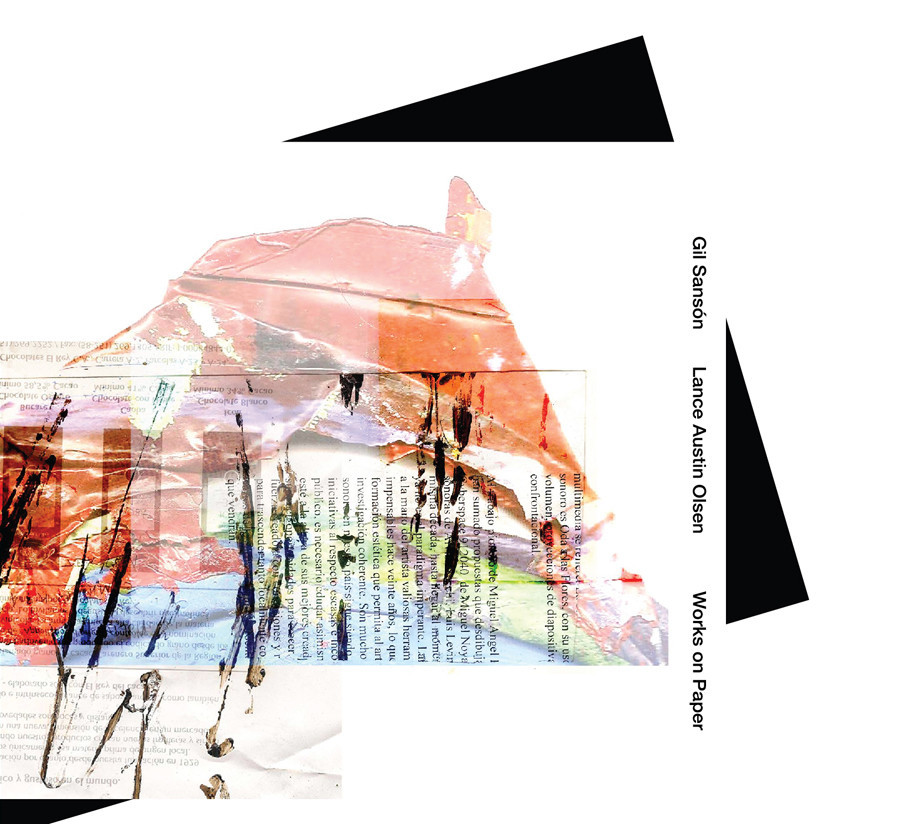
Venezuelan-based composer/artist Gil Sansón and Canadian-based composer/painter Lance Austin Olsen began to work closely together via long distance in 2014. Their collaboration initially began when Olsen painted the CD cover of Sansón's release 'Immanence, A Life' (Makam 003) in 2015. Sharing a similar aesthetic in art and music with deep respect and understanding of each other's work, the two soon started to make music in collaboration through realizations of each other's graphic scores or paintings.
Their first collaborative piece 'A Meditation on the History of Painting (2017)' was published as one of the four tracks of Olsen's notable 2018 release 'Dark Heart' on Another Timbre label. Their collaborative relationship has been rapidly flourishing and deepened with intensity since then. Subsequently, Sansón and Olsen recorded four new collaboration pieces in 2017-2018: two variations of the interpretation of Olsen's painting/
Sansón said, "At some level, I find no distinction between painting and sound making. The processes are similar in essence and they seem to come from the same place. In the case of Lance's paintings, I find a great example of this. He is able to switch mediums and combine them as if there were no actual distinction. I believe the idea that you can make music that is both radically modern without sacrificing the idea of beauty, which to me remains essential and grounds me in the centuries-old tradition of Western classical music, so dear to me since I was a child."
Their realizations are exquisitely layered collages of sparse sounds of musical instruments, objects, electronics, field recordings, voices, and fragments of their past compositions and early classical music as samples, creating an open, profound expansion of the horizon of the music. The intense, vibrant raw energy and graceful beauty immanent in both artists’ pieces are organically integrated into one whole album, forming an epic arch that connects the inner worlds of the two artists poignantly yet meditatively.
The double CD is a limited edition of 500. Besides CD format, digital HD FLAC 24/96 files are available on the label's website, as well as CDs and lossless files on Bandcamp. (We accept CD preorders on both sites.)
(Release date: January 29, 2019)
FACTS
Lance Austin Olsen (born 1943, London, UK) has represented Canada in a number of international biennials with his large-scale painting and drawings, which have been shown extensively in Canada and Europe. His working method is uniform across all of his mediums: a surface is endlessly reworked, with each subsequent piece forming a record or narrative of ongoing discovery. Often in recordings, sections of completed works are folded into new works in the same way that fragments of older paintings and drawings can be added into new paintings as a collaged element. Through this
Olsen began working with sound in 1997 when he met the young artist Jamie Drouin, with whom he has continued to collaborate, releasing limited edition small run albums on their label Infrequency. Through this small label many contacts have been made with other musicians and composers that have formed alliances and new improvising
Olsen started painting at the age of 15, when he entered London’s Camberwell Art School, studying under well-known contemporary artists Frank Auerbach, Euan Uglow
Gil Sansón (born 1970) is a Caracas-based self-taught composer whose musical origins are in rock,
TRACK INFO
CD 1: Gil Sansón (realized and recorded in Caracas, Venezuela, 2017-2018)
1. Pra Mim #2 - Works on Paper (Lance Austin Olsen, 2016) 36:26
2. Pra Mim #1 - Fail Better (Lance Austin Olsen, 2016) 26:14
CD 2: Lance Austin Olsen (realized and recorded in Victoria BC, Canada, 2017-2018)
1. Meditations #3 (Gil Sansón, 2017) 28:30
2. Meditations #2 (Gil Sansón, 2017) 26:10
CREDITS
CD1-01
Pra Mim #2 - Works on Paper
Gil Sansón (acoustic guitar, melodica, violoncello, electronics, objects, field recordings), A. F. Jones (spoken voice). Samples include: excerpts from Sansón's Untitled (for Antoine Beuger) and Untitled (for Annmarie Mattioli), performed by Dante Boon (piano); excerpts from Antoine Beuger's Monodies pour Mallarmé, performed by Anna Rosa Rodriguez (soprano voice) and Gil Sansón (melodica)
CD1-02
Pra Mim #1 - Fail Better
Gil Sansón (voice, unplugged and plugged electric guitar, melodica, objects, electronics, field recordings)
CD2-01
Meditations #3
Lance Austin Olsen (guitar,
CD2-02
Meditations #2
Lance Austin Olsen (guitar, amplified objects)
mastered by Taku Unami
cover
inside graphic scores Pra Mim by Lance Austin Olsen (left) and Meditations by Gil Sansón (right)
produced and designed by Yuko Zama
p+c 2019 elsewhere music
HP: www.elsewheremusic.net
My Year-End List (Releases) of 2018

I am still catching up with listening to this year's releases one by one, and besides the list below, there are some more recent discs that I did not have a chance to check out yet but am looking forward to listening to when I have more time next year, then perhaps I may make another list as Part 2. But for now, these fourteen recordings are so far my favorites from this year. I omitted the five releases from my own label elsewhere although all of them are my favorites of the year as well. My personal favorite is MusicAeterna under Teodor Currentzis - Mahler: Symphony No. 6 (Sony Classical).
----------------------------
(in alphabetical order)
Pierre-Laurent Aimard - Messiaen: Catalogue
Sergei Dogadin / Nikolai Tokarev - Dmitri Shostakovich: Violin Sonata in G Major & 24 Preludes, Op. 34 (Arr. for Violin & Piano) (Naxos 8573753)
English Baroque Soloists & Monteverdi Choir under John Eliot Gardiner - Monteverdi: Il
Morgan Evans-Weiler - iterations & environments (rhizome.s #23)
Jürg Frey & Magnus Granberg - Early to Late (at121)
Eva-Maria Houben - Erik Carlson / Greg Stuart – Duos (digital self-release)
Kukuruz Quartet (Philip Bartels: piano, Duri Collenberg: piano, Simone Keller: piano, Lukas Rickli: piano) - Julius Eastman Piano Interpretations (Intakt306)
MusicAeterna under Teodor Currentzis - Mahler: Symphony No. 6 (Sony Classical)
Lance Austin Olsen - Dark Heart (at128)
Michael Pisaro - Étant donnés (gw014)
Teodora Stepančić / Assaf Gidron / Martin Lorenz – Michael Pisaro: Concentric Rings In Magnetic Levitation (Dumpf 10)
John Tilbury / Keith Rowe / Kjell Bjørgeengen - Sissel (SOFA563)
Christian Wolff / Antoine Beuger – Where Are We Going, Today (ERST083)
My Year-End List (Live Performances) of 2018
2018 has been quite a busy year for me with so much producing work for my newly launched elsewhere label, in addition to the design works for Erstwhile Records and Gravity Wave, so I barely had a chance to listen to this year's releases on other labels besides our own. I must say, I love all the elsewhere titles which I have listened to numerous times during each production and these titles are definitely my favorite releases of 2018. But I am also looking forward to listening to other labels' releases one by one, perhaps later next year when I have more time.
Meanwhile, I made a list of the concerts I went to in the NYC area this year and was particularly impressed with. Among them, there were eight performances that were most memorable, which you can see under the long list of 22. If I had to pick one performance from the list as my best live music experience of 2018, I would pick Seth Parker Woods' premiere performance of Jürg Frey's 'Sounds Sing Themselves' (2018) at ARETÉ, NYC on December 13. It was the quietest and subtlest yet the most profound and moving music that I heard this year.
There were some other exciting concerts that I was looking forward to attending but could not make it due to my busy work schedule, etc., which I really regret, but I hope to have a chance to hear those musicians again in the coming years.
22 Memorable Live Performances of 2018
(chronological order)
Budapest Festival Orchestra under Iván Fischer with Dénes Várjon (piano) (David Geffen Hall, NYC 1/14)
Bach - Orchestral Suite No. 2 in B minor, BWV 1067 / Beethoven - Piano Concerto No. 3 in C minor, Op. 37 / Rachmaninoff - Symphony No. 2 in E minor, Op. 27

The Cleveland Orchestra under Franz Welser-Möst (Carnegie Hall, NYC 1/23, 1/24)
Johannes Maria Staud - Stromab (NY Premiere, co-commissioned by Carnegie Hall) / Mahler - Symphony No. 9 / Haydn - The Seasons

Melaine Dalibert piano recital (Daniel Goode's Loft, NYC 1/27)
Peter Garland - The Days Run Away (1971) / Michael Vincent Waller - Bounding (2017), Cyclone (2018), For Pauline (2016), Roman (2017), Return from L.A. (2018) / Melaine Dalibert - Musique pour le lever du jour (2017)

Ryoko Akama + Anne-F Jacques (Experimental Intermedia Foundation, NYC 1/29)

Stephen Hough piano recital (Carnegie Hall, NYC 1/30)
Debussy "Clair de lune" from Suite
Schumann - Fantasy in C Major
Beethoven - Piano Sonata No. 23 in F Minor, Op. 57, "Appassionata"
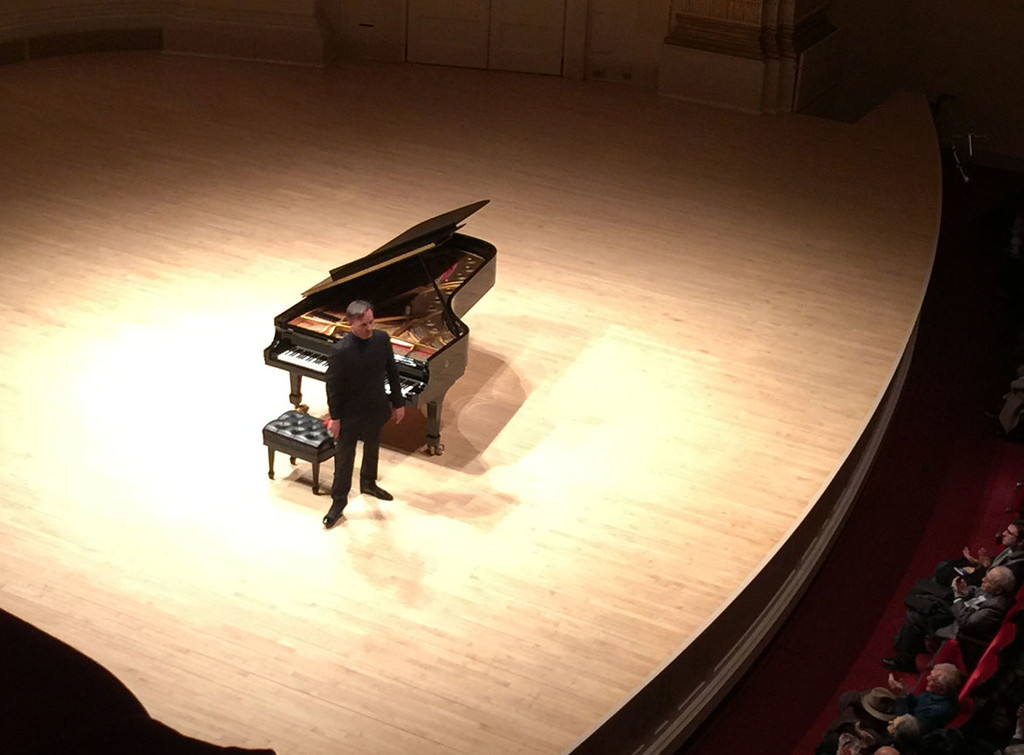
Mitsuko Uchida piano recital (Carnegie Hall, NYC 2/26)
ALL-SCHUBERT PROGRAM: Piano Sonata in C Minor, D. 958 (No. 21) / Piano Sonata in A Major, D. 664 (No. 13) / Piano Sonata in G Major, D. 894 (No. 18)

Boston Symphony Orchestra under Andris Nelsons, with Jean-Yves Thibaudet (piano) (Carnegie Hall, NYC 4/11)
Bernstein - Symphony No. 2, "The Age of Anxiety"

Seth Parker Woods (cello) with Ashleigh Gordon (viola) (The Italian Academy, NYC 4/18)
Giacinto Scelsi - Maknongan (1976) / Claudio Gabriele -

London Symphony Orchestra under Simon Rattle (David Geffen Hall, NYC 5/4, 5/7)
Mahler - Symphony No. 9 / Mahler - Symphony No. 10 (completed by Deryck Cooke)

Bavarian Radio Symphony Orchestra under Mariss Jansons (Carnegie Hall, NYC 5/5)
Mahler - Symphony No. 7

Vanessa Rossetto (Issue Project Room, NYC 5/12)
The Dirt (accompanied by a short film by Matthew Revert)
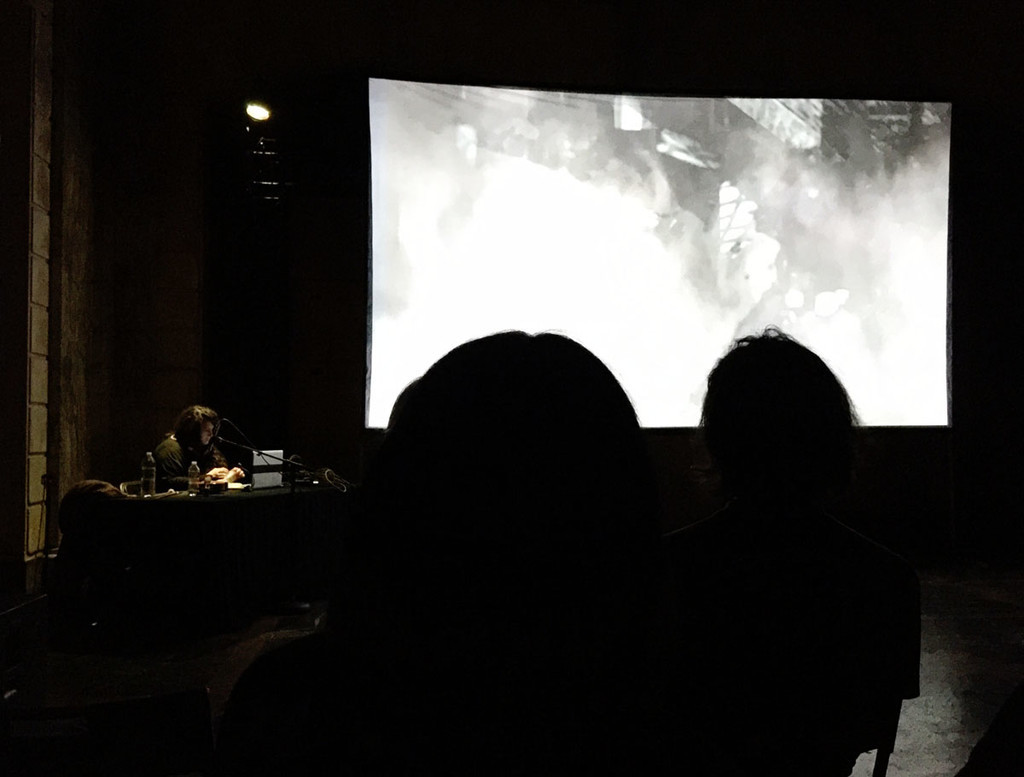
The MET Orchestra under Mirga Gražinytė-Tyla, with Anita Rachvelishvili (mezzo-soprano) (Carnegie Hall, NYC 5/18)
Debussy - Prélude à l'après-midi
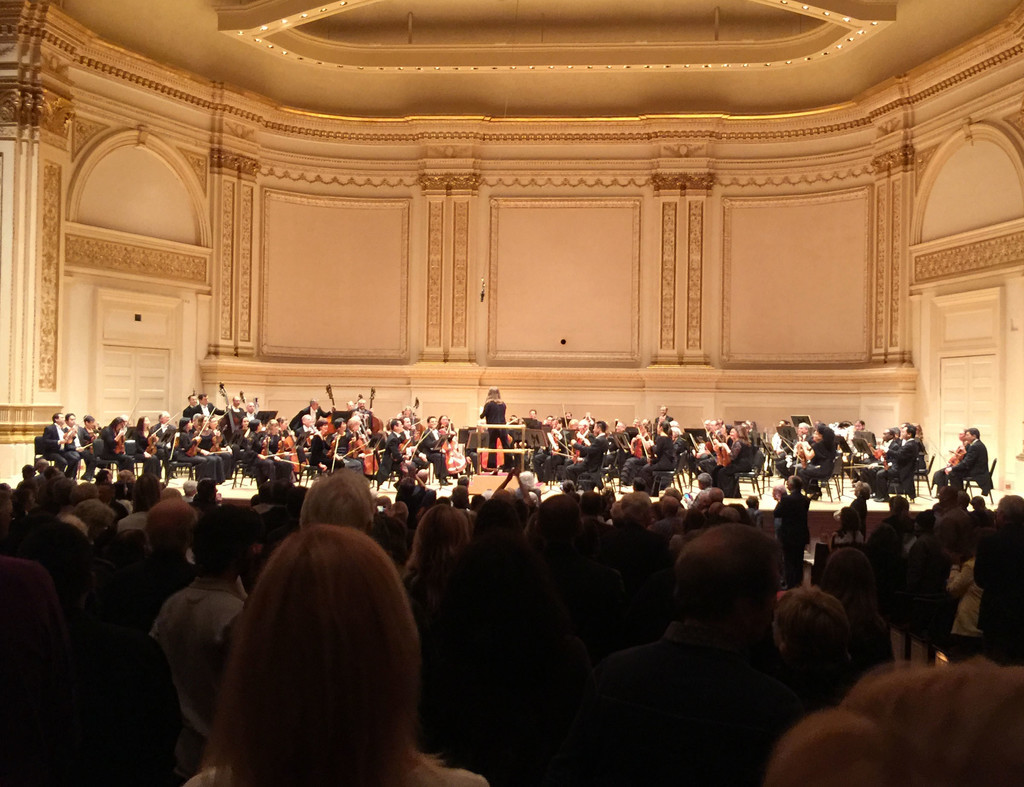
Reinier van Houdt piano recital (Spectrum, NYC 6/14)
Michael Pisaro - Green Hour, Grey Future (2015)

International Contemporary Ensemble / Greg Stuart (percussions) (David Rubenstein Atrium, NYC 8/9)
Michael Pisaro - A wave and waves (2007)

Bozzini Quartet (Clemens Merkel - violin, Alissa Cheung - violin, Stéphanie Bozzini - viola, Isabelle Bozzini - cello) (DiMenna Center for Classical Music, NYC 8/14)
Cassandra Miller - About Bach (2015), Linda Catlin Smith - Folkestone (1999)

San Francisco Symphony under Michael Tilson Thomas, with Leonidas Kavakos (violin) (Carnegie Hall, NYC 10/4)
ALL-STRAVINSKY PROGRAM: Pétrouchka (1947 version), Violin Concerto, Le

Keith Rowe: Extended (Glassbox Performance Space, The New School, NYC 10/13)
Improvisation

Stile Antico (Church of St. Mary the Virgin, NYC 10/13)
Elizabeth I, Queen of Muses (William Byrd, John Dowland, John Farmer, Alfonso Ferrabosco the Elder,

Meridian (Tim Feeney/Sarah Hennies/Greg Stuart) (Project-Q, NYC 10/27)
Improvisation

Mariinsky Orchestra under Valery Gergiev (Carnegie Hall, NYC 10/31)
Tchaikovsky - The Nutcracker (concert performance)

Seth Parker Woods cello solo concert (ARETÉ, NYC 12/13)
Giacinto Scelsi - Maknongan (1976) for any bass instrument / Oliver Thurley - Khepri (2017/18) for solo cello / Nathalie Joachim - Dam Mwen Yo (2017) / Jürg Frey - Sounds Sing Themselves (2018) WP / Monty Adkins - Winter Tendrils (2015) for cello and tape / Giacinto Scelsi - Triphon: Jeunesse, Energie (1975)
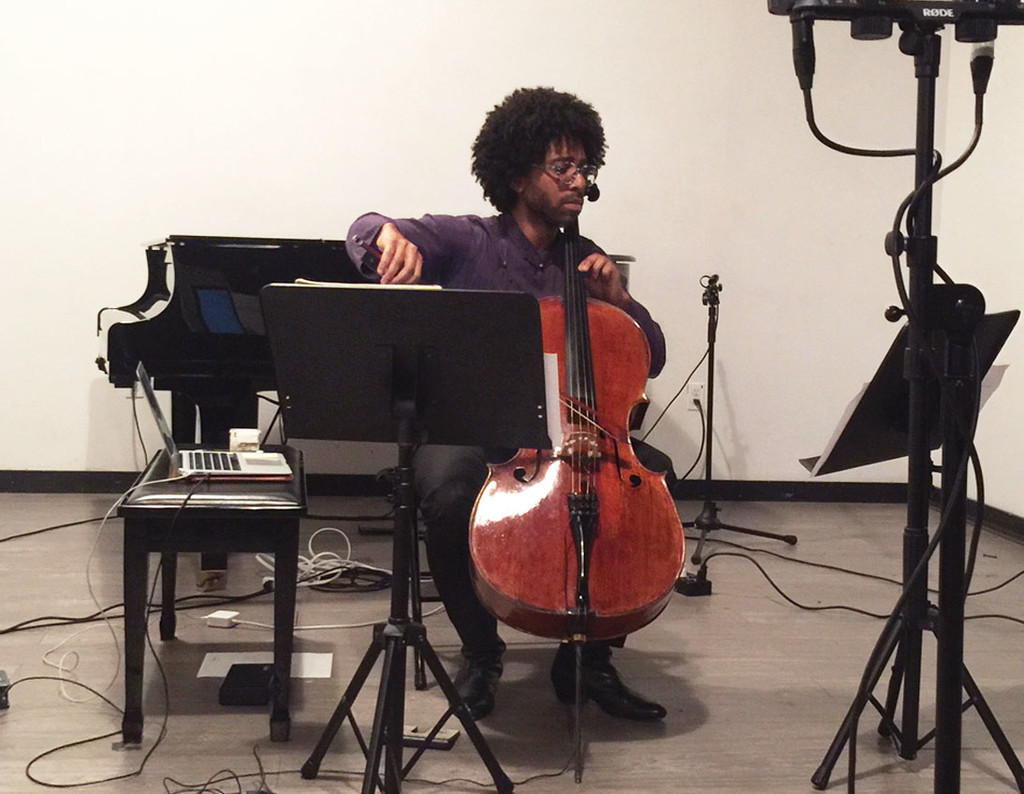
OTHER (Live Streaming)
West-Eastern Divan Orchestra under Daniel Barenboim, with Miriam Manasherov (viola) and (cello) (Carnegie Hall, NYC 11/8)
R. Strauss - Don Quixote / Tchaikovsky - Symphony No. 5
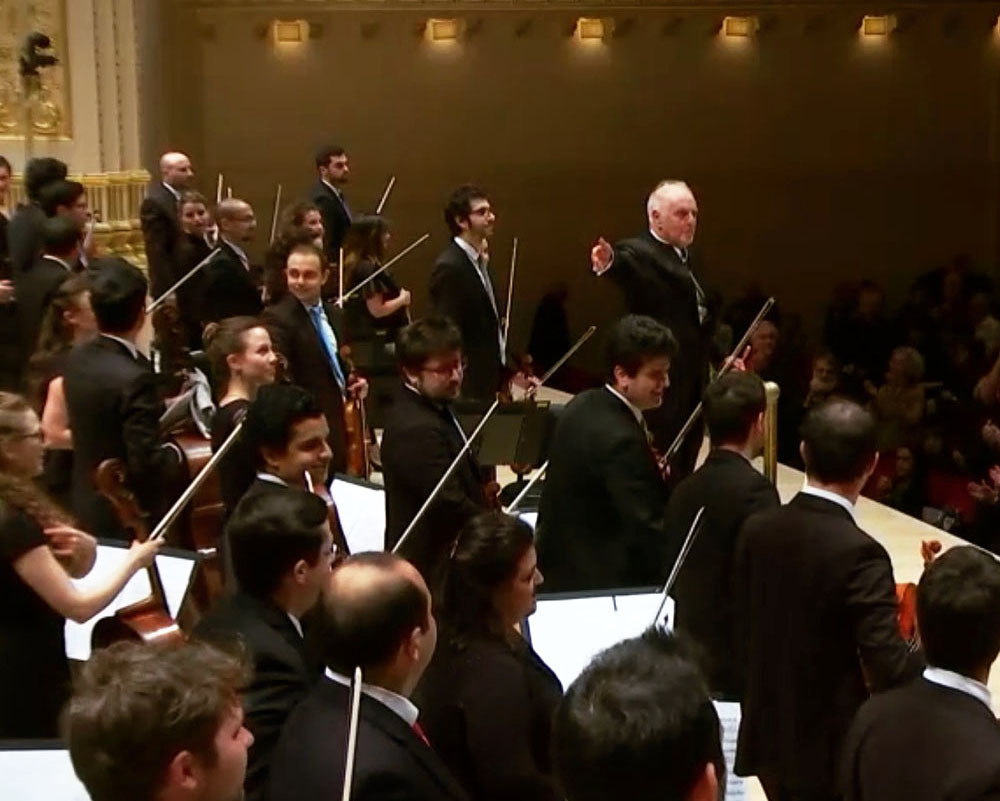
8 Most Memorable Performances of 2018
(chronological order)
Melaine Dalibert - Musique pour le lever du jour (2017) (Daniel Goode's Loft, 1/27)
Mitsuko Uchida: Schubert - Piano Sonata in G Major, D. 894 (No. 18) (Carnegie Hall, 2/26)
London Symphony Orchestra under Simon Rattle: Mahler - Symphony No. 9 (David Geffen Hall, 5/4)
The MET Orchestra under Mirga Gražinytė-Tyla: Tchaikovsky - Symphony No. 4 (Carnegie Hall, 5/18)
International Contemporary Ensemble / Greg Stuart (percussions): Michael Pisaro - A wave and waves (2007) (David Rubenstein Atrium, Lincoln Center, 8/9)
Keith Rowe - Extended (improvisation) (Glassbox Performance Space, The New School, 10/13)
Seth Parker Woods: Jürg Frey - Sounds Sing Themselves (2018) (ARETÉ, 12/13)
Q&A about the two compositions on '120 Pieces of Sound' with Jürg Frey
"I think the question is not ‘how to get it’, but ‘how not to destroy the openness’ when we compose."

YZ (Yuko Zama): I listened to your two recordings of 60 Pieces of Sound and L'âme est sans retenue II in a row, and the experience was fascinating. After listening to the instrumental ensemble of 60 Pieces of Sound, the layers of the field recording sounds in the latter piece sounded like harmonious music to me. It was similar to what I have experienced when I listened to your 6-hour piece L'âme est sans retenue I (
JF (Jürg Frey): Yes, 60 Pieces of Sound and L'âme est sans retenue II are sounding in a profound neighborhood, and I'm very happy to have the two pieces on the same disc.
YZ: Can you tell me how you came up with the idea of putting these two pieces together on one CD?
JF: Last November, we recorded a couple of pieces including 60 Pieces of Sound with the musicians of Ordinary

Jürg Frey and Ordinary Affects (Morgan Evans-Weiler, Luke Martin, Laura
YZ: When you composed (or conceived the initial idea of) 60 Pieces of Sound, did you have a similar concept or structure of L'âme est sans retenue II in your mind, intending to make these two pieces related to each other, by similarly applying the idea of 60 pieces of sound? Or was it more like a coincidence for you to come up with the idea; one for the sounds of field recordings + your clarinet, and the other for a chamber ensemble + your clarinet? I am curious if it was your original intention to relate these two pieces from the beginning, or if you found the connection later?
JF: When I wrote 60 Pieces of Sound, I did not have L'âme est sans retenue II in particular in mind. There was a 10-year interval between the two pieces. I see this work (L'âme est sans retenue II) in the context of my work with ‘lists’, starting in
YZ: How did you apply the idea of a ‘list’ to compose 60 Pieces of Sound?
JF: Over the course of years, the idea of a pure list extended more and more to the list that makes connections of items with each other (what means melody). And 60 Pieces of Sound has a list in the background as a two-part melody. I remember I was at the time working very hard to find an instrumentation, harmonization, color expansion to open this two-part melody/list, but without good results. And then I decided to keep the two-part and to add a third voice, an open instrumentation part for any instrument(s) or sound maker(s). I was immediately pleased how good this score looks like, but not just this good-looking score with the three voices, also the possibilities for different realizations opening in a wide range of performances in the right way was exactly what I was looking for.

Jürg Frey (photo © Alannagh Brennan)
YZ: It is quite fascinating to imagine how your score of 60 Pieces of Sound could make each performance unpredictable and surprising with the potential to induce different harmonization with the open 'third voice' (of three instruments in this recording), while having the very subtle, minimal development of the almost unrecognizable existence of a written melody played on two instruments. It also resonates with the subsequent piece L'âme est sans retenue II, and I can 'hear' the residual images of the sounds and harmonies half-formed in my mind as a part of my memory, which immediately
JF: Thanks for these insightful thoughts about harmonization and openness, and I appreciate your remark about the dialogue and the interference between the two pieces. I feel this CD and these two pieces as a fundamental basis of my feelings and my composing, and even if my music later discovered other territories, I think my recent music connects with this pair of two works.
YZ: One thing I really like about 60 Pieces of Sound is the ‘openness.’ The 'openness' is very important for my listening experience whatever the music it is (especially when it comes to contemporary classical music), since it is the area where I could relate to the music while still being myself, breathing the air in my own rhythm and space, inspired for a further development of the music (in my mind) to relate myself to the music in somewhere half-way from the actual music to elsewhere, not in the limited realm of the composer's score. Thoroughly and precisely structured compositions can be very beautiful, but also often make me feel uncomfortable with its rigidity, however impeccably composed and performed the piece is.
Meanwhile, the minimal involvement of the harmonic elements in your 60 Pieces of Sound makes the music open and free for each listener's perception of the 'music', which partly formed in his/her mind with the help of faintly appearing and diminishing fragments of dissonant/consonant harmonies. They also grow in the subsequent silence and also in the following section of sound, with a discrete accumulation of the translucent memories of sounds and harmonies. I think this phenomenon of the ‘vague yet complex harmonization’ induced and formed in an open space (or the listener’s mind) is quite fascinating.
JF: I'm glad to say something about it. It's a fundamental issue. How can we get this openness? I think the question is not ‘how to get it’, but ‘how not to destroy the openness’ when we compose. The openness is already

(1st page of the score to the two-part melody of Jürg Frey - 60 Pieces of Sound)
YZ: By the way, I have been playing the two-part melody of your score of 60 Pieces of Sound on piano. It is such a haunting, beautiful melody. I played it in different tempos; moderate, slow, very slow with silences between notes. I found that the two-part melody evokes a profound world of beauty especially when it is played very slow with silences between, as if a meditative yet substantial space was expanding around each set of two notes, gradually changing its color and temperature over the time like slowly descending in a spiral. Each set of two notes has a vertical, contemplating depth (which reminded me of your solo piano pieces), but as a whole, all 60 pieces of the two-part melody are closely connected to create one beautiful, organic flow. This melody is almost unrecognizable when listening to the recording of five musicians, with a long break of silence between sections, but starts to form a half-translucent, ‘ghostly’ image of a faint harmony after listening to the whole piece several times. A hint of harmony is more evocative and haunting than a clearly recognizable harmony. It could induce various possible images in the listener’s mind, like a forest of trees in different colors and different shadows yet closely united as a whole via the invisible thread of the mysterious two-part melody deep underneath.
JF: I like your thoughts about the two-parts melody and the experiences when you play it. Not necessary to mention how many times I played this melody for myself...
YZ: Another intriguing thing about 60 Pieces of Sound is that the trace of a harmony in the group ensemble feels not always exactly the same as the written two-part melody in the score. The two-part melody could become a 'trigger' to bring out more variations of harmonies in the resulting music, making the music richer, more pliable, unpredictable, and variable in different ways depending on who would play in the ensemble. It is such a minimal yet perfectly balanced composition with an ideal 'openness', which would also never fall into an incoherent realization out of the right context due to the basic core
JF: You said, "the two-part melody could become a 'trigger' to bring out more variations of harmonies in the resulted music", and this was the key, at a time when I was blocked with the piece. I tried at that time to write different instrumentations and more or less complex chords with the two-part in the background, to elaborate this and that, but things became blurry and blurrier, the two-parts were disturbed or destroyed or stupidly exposed, no good results.
And then I learned, okay, it's the other way around, and I don't have to load the two-part with my ideas, but the two-part can be the trigger to bring out all these things I was looking for. (These are, by the way, good moments in the life of a composer: after going and working for months in a direction, and then, at some point, to see, it's the other way around. It's just simple, I have to change the direction of thinking and working, and then I have it).
YZ: In the 'open instrumentation part’ beside the cello and your clarinet in 60 Pieces of Sound, are the "third voice" musicians tried to form ‘a chord’ in each section in his/her own way by reference to the two-part melody? Or was it supposed to be totally open and free for each musician to play whatever pitch or sound (without considering to form a chord/harmony in mind)?
JF: In principle, it is a free decision for each musician, they may choose any sound, pitch, or noise. At the same time, every musician is supposed to act within the context of the two-part melody, and every decision for this or that is in relation to the two-part. You can try the similar experience when you play the two-part and add a third pitch on piano. Apart from the fact that there are limitations due to the span of the hand, you will see your decisions are completely woven into the given structure of the two-part melody. With three musicians playing the third voice, these decisions are less crucial, also less momentous, because the chord is somehow misty and the single decision is integrated into the overall sound.
YZ: Did the ‘third voice’ musicians discuss with each other (and also with the musicians playing the two-part melody) about what pitch (or sound) to play before they actually performed together, to try to bring a certain unity in each chord section? Or did they not know what kind of pitch or sound other ‘third voice’ members of the ensemble would play until they were actually performing the piece? In other words, was there any pre-arrangement among the ensemble musicians in the way they formed each chord for 60 sections?
JF: There was never either any discussion or pre-arrangement during the rehearsal, nor after the concerts nor during the recording. I think it was also a great luck for me to work with such an ensemble of good musicians, composers, who are used to listening, too.
YZ: Did the ensemble play exactly the same sounds in each concert and rehearsal in Boston and Wesleyan last November? Or did they play different sounds (pitches) each time?
JF: Different sounds. Again, the main thing is to listen and to react with sensitivity to what is going on. Then discussions were not necessary.
YZ: I love the way each chord sounds slightly 'off' without forming a perfect tonal balance in this recording of Ordinary
JF: I think, it's also the "sound of the ensemble". You hear the interests of the group in sound, harmony, the experience with overtones, the sensitivity for tunings. And for this piece (and my music in general), it's definitely a stroke of luck.

(above: a sketch for L’âme est sans retenue II-4)
YZ: I would like to ask you some more questions about L'âme est sans retenue II. When you composed and edited this piece incorporating with the sounds of a bass clarinet, did you intend to induce 'harmonization' in a similar way as in 60 Pieces of Sound, by adding a bass clarinet minimally relating to the field recording sound materials, in addition to your concept of the list of ‘words’? The other two pieces of the series (I and III) were composed without musical instruments, so I wonder if you intended to make a bass clarinet to 'bind' the fragments of the field recording sounds into a vaguely harmonious group via the least minimum interaction of a musical instrument?
JF: It was exactly how you described the procedure. It was an empirical procedure. I tried out the bass clarinet sounds for every field recording till I found the exact pitch and volume to blend with the recording. I wanted to sharpen the harmonization that I had already heard in the recording, to add a fundamental tone, a dissonant or consonant sound to clarify the dust of harmonies and slightly to give him a ‘direction’. To find these pitches, it was the work of the ear.
YZ: In L'âme est sans retenue II, did you play bass clarinet from the start to the end in every 60 group of sounds, with no break (except the silence part) like you did in 60 Pieces of Sound? I could not tell that since it sounded almost unrecognizable in some parts.
JF: Yes, every sound is with bass clarinet. Sometimes it is nearly inaudible. That’s right, you might hear it as if you were hearing just the field recording. The acoustic situation here is similar to the live performance, but then you see the player playing, also when I play extremely soft. For the editing we discussed the question of the bass clarinet volume, the goal was to avoid in any case making the field recording to sound some kind of accompaniment of the ‘soloist’, and to have the bass clarinet as much as possible as a part of the field recording, like hearing the bass clarinet sounds inside, sitting inside the field recording.
YZ: It is interesting to know that even though these two pieces were not intended to be related, they feel somewhat closely connected with each other when we listen to both together. I also think that putting out this L'âme est sans retenue II with 60 Pieces of Sound on one CD will mark a beautiful closure to the entire L'âme est sans retenue series (exactly 20 years since the first piece of the series was composed in 1998). It is so great to see how these pieces are connected with each other to form a beautiful arc over two decades.
JF: I listened to 120 Pieces of Sound again, I am so happy about this release. It's such a good feeling, after all the work, to have the CD now. And I remember also a title of a Richard Long sculpture: 147 (?) Pieces of Wood. I was at the time, many years ago, very fascinated by this title (and also by the
(Interview conducted by Yuko Zama, September - October 2018)

Richard Long, Somerset Willow Line (1980) Installation view at The Hepworth Wakefield, Photo © Stephen Jackson
Jürg Frey - 120 Pieces of Sound (elsewhere 003) is now available at the label's website (CD, lossless digital 16/44, HD FLAC 24/96), Bandcamp (CD, Lossless Digital 16/44, streaming), Metamkine (CD) and
Q&A about 'about' with Stefan Thut and Ryoko Akama
"These silences are soon getting replaced by something else: by the sounds from before, by the sounds in expectation,

YZ (Yuko Zama): Ryoko, I heard that you were the person who initiated this recording project. How did you come up with the idea of this project?
RA (Ryoko Akama): I moved to the North of England in 2012. Since then, I had occasionally organized concerts and eventually set up '
YZ: Why did you decide to ask Stefan
RA: I enjoy what his music delivers in every aspect, in terms of composition, performance, and aesthetics. Stefan's music is sensible and delicate, but also is very determined. I like how he integrates ideas of the musical and the non-musical into a piece. The same respect goes to lo
YZ: Stefan, when Ryoko commissioned you to write a piece for her ensemble (for six musicians), what came up in your mind as an inspiration or idea?
ST (Stefan
YZ: Ryoko and Stefan, what led you to decide to record this piece with this particular ensemble of six musicians (including Stefan and you)?
RA: We had an afternoon workshop and evening concert a day prior to the recording session at Access Space, Sheffield. Stefan composed a piece ‘away’ for a trio of himself, lo
ST: Ryoko did not directly ask me to write a new piece for the occasion. She suggested to meet, play, and record some of my music. Then I had to find out what 'my music‘ could be for the project. Of
YZ: Why did you name the title of the piece 'about'?
ST: The title came from the activity of 'walking about'. I knew the space from a performance of my

Stefan Thut 'about' score (page A1, B1) (2017)
YZ: What was the main concept (or an idea) for this composition ‘about’? Or, what did you and Ryoko want to achieve via the realization of this particular piece?
ST: With this composition, I was interested in how to attribute a meaning to silence while basically playing sounds throughout the entire piece, though with pauses. This may sound contradictory at first sight. I was looking for a specific kind of sound that made us want to let time pass before playing the next sound. That is why there were short sounds occurring, mostly hit, plucked or bowed shortly. The most important element was that of the ringing material, the vibration of the string after having been set in motion, the activation of the air inside the bottle by ear aid devices. This again is connected to our recording situation.
YZ: This recording gives me a unique sensation of experiencing the sounds synched with me 'inside' my brain, while I also feel the sounds coming from far from 'outside'. There is this really nice open feel in the piece, and at the same time, it also contains the sense of "unity" or a silent intensity in the atmosphere, without each musician's sound scattering around with random activities at all. This experience of feeling different perspectives (inside and outside) in a sense of unity is very interesting to me, and seems to give the piece a very wide open, free space for the listeners to experience the "sounds" and "silence" both inside their minds and outside their realities at the same time. Did you intend something like that with this piece?
ST: Thank you for the beautiful description - reading this tells me about the intertwining of listener -
By the way, your words remind me of Rilke’s first verses of the opening of The Sonnets To Orpheus:
There the tree rises.
(in the German original, literally: oh great tree inside the ear)
And all is silent, And from this silence arise
New beginnings, intimations,
(Rainer Maria Rilke The Sonnets To Orpheus, English translation © Robert Temple 2010)
YZ: Fascinating connection! There is a large amount of silence in this piece, but what did you intend to attain with these silences in this piece?
ST: Structurally speaking, there are silences occurring again and again. On the other
What I am interested in here is to not just leave space with silence but a group situation wherein silences occur as an outcome of the musicians' activity. Here each performer follows the vanishing of sound and only thereafter continues with the next sound. This process is multiplied by the number of performers: six pairs of ears are aware of the decay of sound (according to the score). For me, this kind of focus on 'something vanishing' created a state of pure attentiveness.
YZ: What did you like about this particular ensemble of musicians?
ST: I was impressed by their carefulness, their curiosity about their own sounds and the sounds of the others. It is a rather unusual and unique situation to get together in a certain setting to record immediately without a preliminary performance. I think Ryoko had the genuine intuition that this was going to work.
YZ: In our early email, you mentioned that all the musicians felt as if they were 'elsewhere' after the performance. Can you tell me more about the special experience (or sensation) that you and the musicians felt after the performance? And what sort of natures (in this music) do you think brought you all to this special feeling?
ST: I think this kind of music provokes a drifting of the mind. In my experience it is inevitable.
YZ: If there was one (or more) thing which all of your musicians were sharing during the performance, what do you think it was (or they were)? Was there any particularly strong sense of a concept that all the musicians kept in their minds during the performance?
ST: What we all shared was the possibility of having two states of being organized: that of acting in the group and that of ‘being on one’s own’ by standing up, making a few steps, and saying a word. The latter was not necessarily addressed to the group. The words appeared for
YZ: If there is anything else you have in your mind about this piece and the recording of these musicians, or anything particularly impressed you concerning this collaboration?
ST: Each word was meant to be a sound that had one impetus, reminiscent of the sound quality of the previously performed tones on each instrument. With the use of monosyllabic words, the level of semantics is not apparent. The multilingual situation makes the words even more
YZ: Ryoko, how did you (and other musicians) feel after performing this piece together?
RA: I personally find it hard to use my voice in performances. A non-vocalist tends to get self-conscious about his/her own voice. Moreover, this piece asked performers to ‘walk around’

(Recording session of 'about' with Simon Reynell in September 2017)
The recording happened in Phipps Hall at the Huddersfield University. I chose the space for some practical reasons, the acoustics, equipment availability
Strangely enough, performing a score like ‘about’’ has a similar mentality. I felt that sort of sense when we performed the piece. The first take was a little awkward but the second and the third were more naturally embedded into the situation. Stephen concentrating on his guitar and forgetting everything else around him, Eleanor plucking piano strings so gracefully, Stefan observing and carefully listening, lo
Listening back to the piece is a different matter. Now, the music permits another environment. I am more objective, in a room away from where I was. Now, I experience silence differently, and silence is different from what it was then. The piece evokes a new scene in my alone time. This is a beautiful metamorphosis of a score. I wonder if I can call this moment - an afterlife of the score - the ever-changing translation and the rebirth of a creative work?
(Interview conducted by Yuko Zama, September - October 2018)
Stefan Thut - about (elsewhere 005) is available at the label's website, Bandcamp, Metamkine, and
Q&A about 'Without' with Clara de Asís
“In order to form a whole, you have to be simultaneously with and without the rest of the elements.”

YZ (Yuko Zama): I heard from Greg and Erik that they asked you to write this piece 'Without' for their duo. Can you tell me what came up in your mind when you were thinking about writing a piece for a duo of violin and percussion, or particularly for this duo of Greg and Erik?
CA (Clara de Asís): I wrote this piece particularly for Greg and Erik. Even if I knew and highly appreciated each of their respective works and collaborations, I had never listened to their work as a duo before. My first exposure to their duo was their recording of Eva-Maria Houben’s ‘Duos’, a wonderful album that they had recorded recently, which they introduced to me during our first exchange. What struck me from their realization was that I found a great symbiosis between the two, but both kept the uniqueness that distinguishes their voices. As if it was
I can say this was one of the main (or part of) thoughts that I had in mind when I started working on the piece. So I contemplated two “parallel” existences that would have an organic relation. Like looking at no matter what vision, what landscape, what direction. We can see elements that exist individually, but still in permanent relation with each other, bringing up something else, something arising from that.
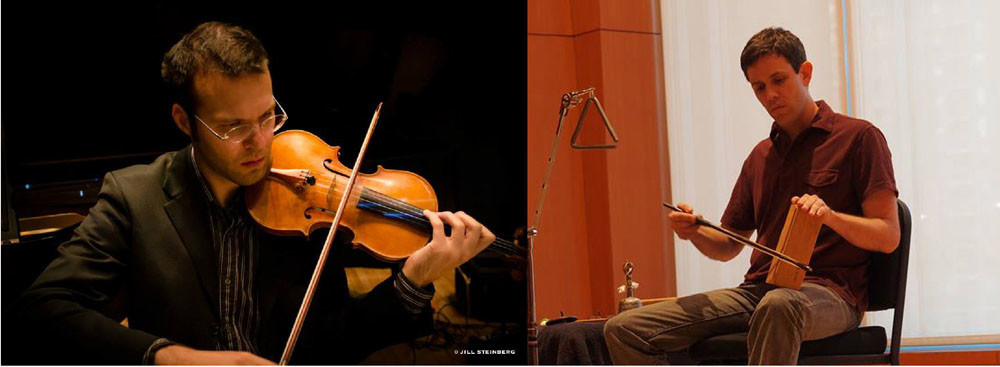
Erik Carlson (photo © Jill Steinberg), Greg Stuart (photo © Tom Stuart)
YZ: Was there anything that inspired you to write this piece? (Like some particular influence from some art, film, music, landscape, your own experience, etc.)
CA: I don’t think I get conscious inspiration from things that I’d apply directly, but it’s rather
YZ: Can you tell me about the title "Without", like any thought or concept behind the title?
CA: I came to the word ‘Without’ after some time, in the last place, once that the piece was composed. It came as a verbalization of some thoughts that I had been having, but that
For the with to be possible, there must be a without.
It expresses the ambivalence of the elements in a whole. Because for a whole to exist, the elements are together, are with each other, but in order to be so, every element must also exist without the rest; exist, let’s say, individually. In order to form a whole, you have to be simultaneously with and without the rest of the elements.
Also, that word, ‘Without’, I was feeling in the piece some kind of affinity with it. Because of the simplicity of the piece. Simplicity versus addition.
‘Without’ evokes lightness to me.
YZ: My impression of the piece was that it contains some sort of a minimal silent beauty which resonates with an aesthetic of a Zen garden while containing the Western aesthetics in the colors and the textures of the sounds (as well as the vibrant energy underneath), in the meditative stillness. It is a simple but well-thought composition with the perspective of the 'openness' and the 'depth'. The intensity of the sparse sounds and silences is remarkable, and most of all, it feels so organic like watching a landscape in nature. Did you have any particular image (or anything) in your mind when you conceive and compose this piece?
CA: I really like your impression of the piece and it touches me
YZ: When I listened to the mix of Without for the first time, I was particularly interested in how the ‘silence’ in your piece felt different from other composers’ works I was familiar with. Silence could obtain various different natures depending on how it was incorporated into a composition or a performance – it could feel like a sound, it could obtain a weight, or it could feel as if it was changing the way time passes by, or it could feel awkward if not applied in the right context.
To me, your ‘silence’ felt very organic and unpretentious, containing serene stillness with no extra heaviness or indication. It has a quiet intensity and consistency with lucid
CA: I experience silence as a part of the sound itself. Every sound contains silence. I consider the sounds beyond their highest peak of evidentiality. They are more than just an audible phenomenon. When a sound stops sounding, it hasn’t finished yet; it’s still there. It’s like
Reducing the sounds only to their audible dimension would be like reducing a plant only to its visible result. But there are many other subtle forms of their existence.
We can still perceive things once their highest degree of intensity has decayed. In the case of the senses other than the ear, this is commonly accepted. For instance: after tasting a fruit, we still have the taste of it in our mouth; after staring at a candle, we close our eyes and we see the light; after touching a hot surface, our skin feels hot. – Why would the ear be different?
So I try to adopt a listening attitude that is receptive to the wholeness of what I consider a sound to be, including their silence.
YZ: How did you feel about the way Greg and Erik responded to your composition "Without" and realized it?
CA: Something that I had found individually in both Greg and Erik and that impressed me was (and is) the extreme attention of their listening, and besides a great sensitivity, intelligence and humbleness, and a very precise and subtle technique, how the act of listening is central on their practice.
I just love their realization of the piece. I feel very grateful for their work. I had composed the piece for them to make it exist and they made it exist. Before listening to their realization, I had a sound image idea in my head, but I didn’t have an exclusive expectation about how everything “should” sound. Even if it has a very precise structure, the piece is also open in many aspects, and that openness was for them to go through it. When I listened to their realization for the first time, I was very impressed by how the feeling that I was perceiving of it, matched exactly with the feeling that I had of it when composing it. It’s a wonderful realization.

diagrams for Clara de Asís - Without
YZ: In 'Without', it is interesting since the two performers seemed to switch sides at some point in the piece. Erik was heard on the left and Greg on the right at first, but then they were on the opposite sides in the end. Erik
CA: The thoughts about the space and the motion in the piece came once the score was finished, and Erik and Greg let me know that they were going to record it.
To me, the mixing stage and the recording set up are both directly related to the image of the space in the piece (whereas the writing stage has to do more with time). In this particular piece, concerning
I didn't want Erik and Greg's voices to be in a specific point of the stereo field and not move from there, this would have reduced them to a "call-response" effect that just wasn't coherent with the piece, that wasn't the point at all. And if their positions had switched more or less randomly, a natural flow would
I think that the same
Why choose to switch positions during the mixing stage and not directly during the recording, there were many reasons. You can be a lot more meticulous about the exact position of each voice in the stereo field. Besides that, I was interested in the motion, but I didn't want the motion to imply a result of the sound distancing away from the listener. Getting the motion but not the effect of distancing away from the mic would have been technically more complicated to do during the recording
And if they had done it during the recording, I think that it would have implied a presence in the piece, their physical presence, their bodies moving, even subtlety. While I think that it can be definitely interesting and it's something I’d like to work on maybe at some point, that wasn't the aim of this specific piece. – The second diagram is a suggestion of the position of the mics.
YZ: I saw your live performance in a duo with Lucie Vítková at Keith Rowe's event in NYC this October. I thought it was great. During the performance, you created an intense atmosphere while keeping a wonderful openness, never losing the consistency of the entire flow of the music in spite that your performance contained a large amount of silence.
I often feel that many musicians tend to rely on 'spontaneity' a little bit too much in a hasty way during a live performance (especially in improvisation), trying to fill the space with sounds as minute and various as possible, which often feels as if it narrows down the potential of the music with subjectivity and weakens the structure (to me).
But your performance was anchored in the core of the piece with stability, letting the music flow in an open space by believing what would occur in the course of the set with a great confidence. I was impressed with how you kept the calmness throughout the piece, listening to the sounds and the silences keenly, patiently waiting for the simple minimal sounds to grow in the silence as the music develops, and seeing how simple elements of sounds and silences could accumulate to form a music over the time. Silences felt so organic and seamless as a part of music in your duo performance. I think it was very courageous to keep such an open space with so minimal elements yet never lose its intensity. I found a similar serenity in Erik and Greg’s duo recording in your 'Without', too. I think this naturalness and openness are significant natures that make your music so distinctive.
CA: Thank you very much for your words about my performance at Keith's event. I appreciate that a lot. I must say that I feel a big affinity with your way of
I didn't know how our duo performance at Keith’s event would
(Interview conducted by Yuko Zama, September - October 2018)

Clara de Asís and Lucie Vítková duo at the afternoon shows of Keith Rowe: Extended at Mannes School of Music, NYC (October 13, 2018) photo © Bob Burnett
Clara de Asís - Without (elsewhere 004) is available at the label's website (CD, lossless digital 16/44, HD FLAC 24/96), Bandcamp (CD, Lossless Digital 16/44, streaming), Metamkine (CD) and
PRESS RELEASE: Stefan Thut - about (elsewhere 005)

Stefan Thut composed 'about' in 2017 for a sextet as a part of the first concert series of the art and music project
By going back and forth between these two activities - one with playing the sounds as a group, and the other with individual activities of their own - standing up, making a few steps, and saying a word, the ensemble created a unique openness in the music while each keeping their own contemplative individual experience as a component. Through this piece,
(Release date: October 10, 2018)
FACTS / TRACKLIST / CREDITS
Swiss composer and cellist Stefan
Ryoko Akama is a UK-based composer and performer whose work, ranging from text compositions to sound installations, pursues minimal, reductive, cumulative, and contemplative experiences. Her work aims to offer quiet temporal/spatial
ame (
Stefan Thut - about (2017) 58:44
Ryoko Akama - electronics
Stephen Chase - guitar
Eleanor Cully - piano
Patrick Farmer - metal percussion
lo
Stefan Thut - cello
composition by Stefan
project initiated by Ryoko Akama
recorded by Simon Reynell at Phipps Hall,
mixed and
mastered by Taku Unami
design and photography by Yuko Zama
text by Stefan
produced by Yuko Zama
thanks to: University of Huddersfield and
p+c 2018 elsewhere music
www.elsewheremusic.net
PRESS RELEASE: Clara de Asís - Without (elsewhere 004)
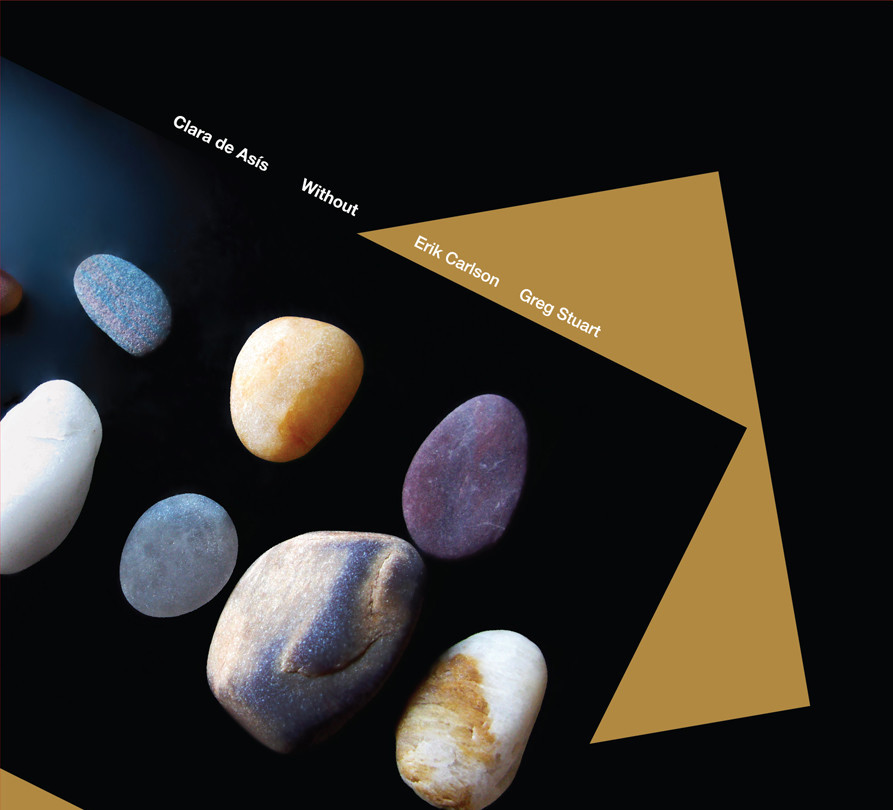
Clara de Asís composed the piece 'Without' for the duo of Erik Carlson (violin) and Greg Stuart (percussion) in 2018. In this 43-minute piece, de Asís gave a precise framework for the position and the duration of each sound section and each silence, as well as a rough outline for the texture and the volume of each sound, the use of tone or noise (or tone-noise), and the materials for the percussion, but a large part of the score was open for the two performers' freedom.
In the realization of this piece, Carlson and Stuart brought out the unique voice of each instrument by applying
(Release date: October 10, 2018)
FACTS / TRACKLIST / CREDITS
Clara de Asís is a Spanish composer and guitarist based in Marseille, France. She studied cinema at
Erik Carlson is a violinist who has performed as a soloist and with many
Greg Stuart is a percussionist whose work draws upon a mixture of music from the experimental tradition, Wandelweiser, improvisation, and electronics. He has also been an invaluable percussionist performing a large body of works of Michael Pisaro and other contemporary composers, while also working on his own projects, collaborating with various experimental musicians including Tim Feeney, Sarah Hennies, Ryoko Akama, Eva-Maria Houben, Antoine Beuger, Frey, and Kunsu Shim.
Carlson and Stuart have been working together as a duo in the last few years, and their 2018 digital self-release of Houben’s ‘Duos' was highly acclaimed. They also performed together on Frey's 2017 album Ephemeral Constructions (Edition Wandelweiser).
Clara de Asís - Without (2018) 43:10
Erik Carlson - violin
Greg Stuart - percussion
recorded by Erik Carlson and Greg Stuart at Conrad Prebys Music Center, UCSD, La Jolla, CA on July 9, 2018
mixed by Erik Carlson
cover photo and inside photo by David Sylvian
design by Yuko Zama
produced by Erik Carlson, Greg Stuart, and Yuko Zama
executive produced by Jon Abbey
p+c 2018 elsewhere music
www.elsewheremusic.net
PRESS RELEASE: Jürg Frey - 120 Pieces of Sound (elsewhere 003)
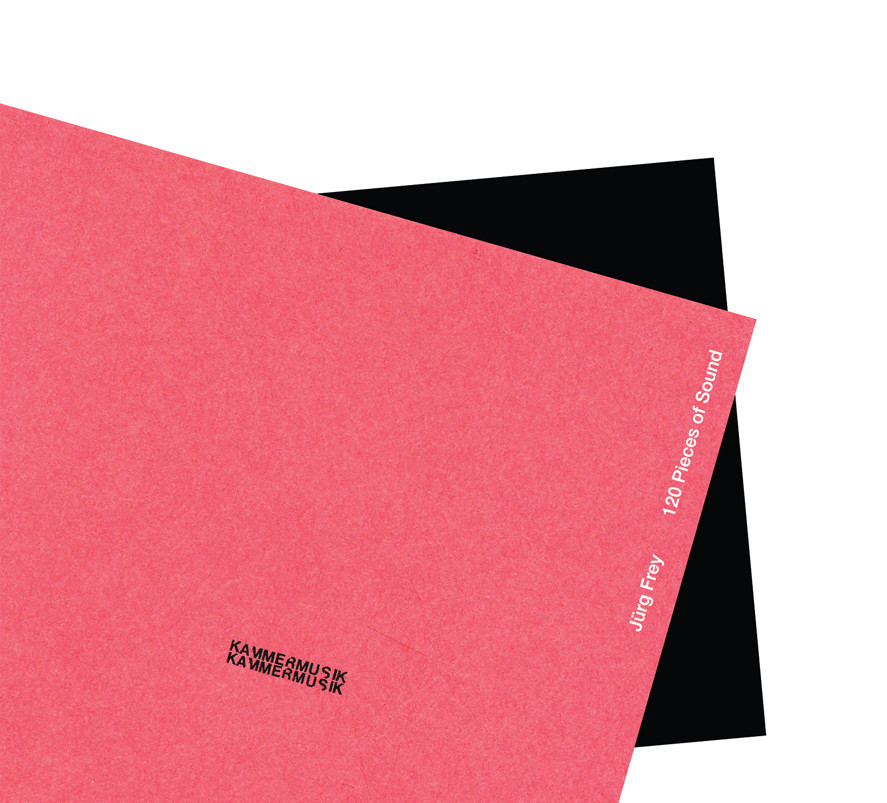
Jürg Frey’s unique compositional approach places him at the cutting edge of contemporary classical music while simultaneously maintaining a touch of impressionistic/romantic aesthetics in its roots. Since the late 90's, Frey started to work with 'lists' as a basis of his compositions, sometimes words, sometimes chords, from which he developed and organized the musical materials. In recent years, Frey's focus on 'lists' has extended more toward the connections of items with each other, forming melodies.
Frey composed 60 Pieces of Sound in 2009, for an indefinite number of musicians; with two instruments that play the pitches as written in the score forming a two-part melody, and an open instrumentation part for any instrument(s) or sound maker(s) as 'the third voice.' Each of the 60 chords played by the ensemble is followed by a similar duration of silence. In November 2017, Frey and the Boston-based ensemble Ordinary
In this recording, Frey's clarinet and
L’âme est sans retenue II was composed by Frey in 1997-2000, edited by him from the field recordings that Frey made in Berlin in 1997 with the addition of his bass clarinet sounds. It is the second piece of the series with the same title, after ‘L’âme est sans retenue I’ (
In this 40-minute piece 'L’âme est sans retenue II', the similar duration of the sounds and silences alternate with each other like in '60 Pieces of Sound’. For this piece, Frey first edited the field recording parts and later added his bass clarinet sound with a certain pitch to every part as an underlying tone that would blend with the field recordings. Frey's bass clarinet is discreet and almost unrecognizable here, often hidden under the complex layers of the field recordings, and yet clarifying the harmonization of the field recordings from inside. These two pieces were not actually directly connected to each other, but presenting these two pieces '60 Pieces of Sound' and 'L’âme est sans retenue II' back to back on this album brings out the fundamental aesthetic of Frey's compositions in regards to how he approaches the ‘harmonization’ and ‘openness’ of the music.
(Release date: October 10, 2018)
FACTS / TRACKLIST / CREDITS
Jürg Frey was born in Aarau in 1953. After studying at the Conservatoire de Musique de Geneve in Thomas Friedli’s solo class, he began a career as a
Jürg Frey is a member of the Wandelweiser Komponisten Ensemble which has presented concerts for more than 15 years in Europe, North America and Japan. Frey lives with his family in Aarau (Switzerland), teaches clarinet, and organizes the concert series moments
Ordinary
Ordinary Affects has commissioned and premiered pieces by Michael Pisaro, Antoine Beuger, Sarah Hughes, Eva-Maria Houben, and Ryoko Akama, in addition to performing a number of other composers’ works including those by Joseph Kurdika, John Lely, and all members of the ensemble (
Jürg Frey - 120 Pieces of Sound (elsewhere 003)
1. 60 Pieces of Sound (2009) 32:00
Ordinary Affects:
Luke Martin - electric guitar
Laura
J.P.A. Falzone - keyboard
Morgan Evans-Weiler - violin
Jürg Frey - clarinet
recorded by Luke Damrosch at Wesleyan University, Middletown, CT on November 10, 2017
mixed by Luke Damrosch and Jürg Frey
mastered by Luke Damrosch
2. L’âme est sans retenue II (1997-2000) 40:03
for field recordings and bass clarinet
Jürg Frey - field recordings, bass clarinet
recorded by Fabio Oehrli at Tonlabor Bern, Bern, Switzerland
mixed and mastered by Fabio Oehrli (Tonlabor Bern)
cover artwork by Jürg Frey - Stück (1974) #29
design by Yuko Zama
produced by Jürg Frey and Yuko Zama
p+c 2018 elsewhere music
www.elsewheremusic.net
Upcoming releases on elsewhere for October 1, 2018

We are happy to announce new releases for October 1, 2018:
Jürg Frey - 120 Pieces of Sound (elsewhere 003)
(60 Pieces of Sound - performed by Laura Cetilia / Morgan Evans-Weiler / J.P.A. Falzone / Luke Martin / Jürg Frey)
(L'âme est sans retenue II - field recordings and bass clarinet, composed by Jürg Frey)
Clara de Asís - Without (elsewhere 004)
(performed by Erik Carlson / Greg Stuart)
Stefan Thut - about (elsewhere 005)
(performed by Ryoko Akama / Stephen Chase / Eleanor Cully / Patrick Farmer / Stefan Thut / Lo Wie)
------------------------------------------
(Reinier van Houdt - Bruno Duplant - Lettres et Replis is scheduled to be recorded late this year for 2019 release.)
photo © Jill Steinberg (Erik Carlson)
photo © Stephen Harvey (Stefan Thut, Ryoko Akama, lo wie)
photo © Susanna Bolle (Jürg Frey, Ordinary Affects)